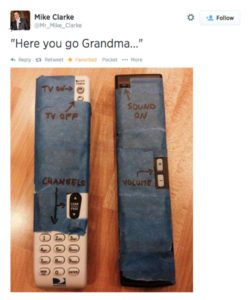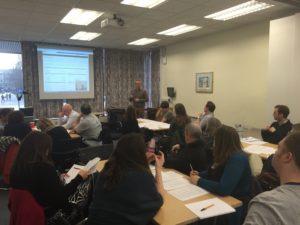Introducing the new usability testing service
I’m introducing a new usability testing service for the University, for an initial trial period up to the end of July 2016. It will be an easy and convenient way to embed user insight into your development projects, and provide learning opportunities for anyone interested in trying the techniques out for themselves.
Thanks to the Information Services Innovation Fund, I have the opportunity to invest in some new equipment and software, and employ staff to help make it happen. This is a really exciting opportunity to scale up services I’ve offered informally in the past when time has permitted. I hope to demonstrate the value of the service to justify its existence on an ongoing basis.
What is usability?
Basically, it’s about how easy, how effective and how satisfying something is to use. We could be talking about a website, a piece of software, a TV remote, an instruction manual, or signage around a building, for example. Essentially, anything that you interact with.
The extent to which a product can be used by specified users to achieve specified goals with effectiveness, efficiency and satisfaction in a specified context of use.
International standard (ISO 9241-11) definition
The usability of something may be impeded by things like:
- Using language, process and structure based on business needs, not user needs
- Focusing on features rather than on the user achieving their goals
- Ignoring the user’s context – their prior knowledge, the situation they’re in when interacting, their technical or personal constraints
- Fundamentally not understanding what is important to the user
We encounter bad usability every day in one form or another. Sometimes it stops us dead in our tracks; sometimes we cope and get over the hump.
What we often don’t notice though, is good usability. When everything is smooth, quick and pain free.
Good usability doesn’t happen by accident. It doesn’t happen through a genius designer who knows how to make things usable.
Good usability happens through regular engagement with the target audience, with all stakeholders in a development or service working towards a common goal of delivering a great user experience.
Luckily, there’s a simple process that can significantly improve the usability of a product. And that’s where this new service comes in.
The new usability testing service
I’m not going to go through the whole process here, as I’ve written about it before. The service is based on the very successful model we used as part of the development process for the new University Content Management System, EdWeb.
Making usability testing agile – my previous blog post details how you can do it all yourself
In a nutshell though:
- We meet and you outline the problems or concerns you have with your website, software or service
- I work with you to understand your users, your goals and the expected context of use
- I organise the design of a short usability test. This could involve your current provision, plans for improvements, ongoing work in development or maybe a competitor’s provision.
- We work together to recruit a small number of test participants, typically 3 to 5.
- I execute the usability test with each of the participants and record everything.
- We get together with your stakeholders to watch the recordings, and I facilitate a process where you collaboratively identify and prioritise the issues you’ve seen.
- You work to address the most critical issues and ideally come back to repeat the process.
So your time commitment in this process would be:
- 2-3 hours to meet initially, then follow up dialogue to refine the focus of the test
- Potentially some involvement in the recruitment of participants – this depends upon the nature and accessibility of your target audience. In many instances, we would cover this for you.
- 3 hours to meet, along with others in your team, to review the test videos and participate in the issue prioritisation process.
Benefits of usability testing
All this may sound a bit time consuming and an expense you can do without.
However, the return on investment of this kind of thing is well established.
Research shows that with an investment of around 10% of the development budget, the return is at least tenfold
The key areas:
- Reduce development costs by being clearer about requirements
- Reduce support costs by making things easier for your audience to use independently
- Save staff time by making software and processes more intuitive and efficient
- Increase engagement with your product or service by creating a more satisfying and useful experience
- Increase conversion by removing barriers to your audiences doing the things you want them to do
Return on investment (ROI)
A few short articles that go into the benefits in more depth with evidence to back it up:
- Return on Investment for Usability – article by Jakob Nielsen
- Benefits of User-Centered Design – usability.gov website
- ROI Of Usability – article by by Megan Wilson
Forthcoming events
As well as running the service for University services and business units, I plan to run some open-invite events over the coming months to promote the techniques I use and encourage more colleagues to do this for themselves.
They’ll take the same form as the session I ran last year to give colleagues a look at how we were developing the EdWeb content management system. But this time we’ll look at a range of business-critical University services. I’m in the process of talking with colleagues who might collaborate with me and expect to announce an event for April very soon.
Interested in this service? Get in touch
If you have plans for usability testing and need some advice or would like to take advantage of this service, drop me a line and we can discuss your requirements.
I can also train your staff to run your own usability testing programme.
Get in touch with Neil Allison to discuss you usability testing requirements
What do you think of the service? Leave a comment
Even if you can’t take advantage of this new service, I’d love to hear what you think. Let me know if you think this is a great idea, or a bad idea, or if you have any questions…




Think this is a great idea – and much needed. Also, hopefully it will help people to stop confusing usability and accessibility being the same thing despite some overlap.- good luck with it all.
Thanks for your support Viki.
I agree that there can sometimes be confusion about usability and accessibility. I think with this service there is a great opportunity to raise the profile of accessibility and its importance to the user experience. As you know, it’s possible for a website or system to be technically accessible but still have significant usability problems. But if something is usable, and the right audiences have been involved in usability research, then it will be accessible.
If anyone is interested in usability testing of their systems or websites with people using assistive technologies, drop me a line. We can do this. I’ve worked with users in the past who have vision, hearing and motor impairments.
There’s a great book out called ‘A Web for Everyone’ which covers accessibility from a UX perspective. I recommend it.
Book excerpt from A Web for Everyone on uxmag.com
This sounds like an absolutely brilliant service, I can already think of 2 or 3 ways we would like to utilise this. Definitely a great idea.
Thanks Ruth. Hope we can help. Do get in touch!
My contact details